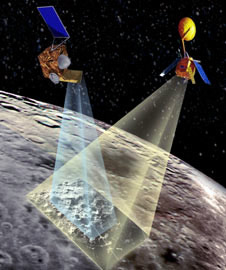Chandrayaan Finds more water on moon- this time it finds ice
 |
| NASA image showing Craters on North Pole of Moon indicating water Ice © NASA |
When Chandrayaan I failed prematurely without completing it's life of two years, Indian media almost went bizarre calling it almost a
failure. Those initial muses were muted by the news that Chandrayaan confirmed water on moon. Now even after six
months after Chandrayaan lost contact with the Earth it is still creating news. Now it finds ice deposits on Moon's North Pole. Guys be ready , may
be we can sure make a trip to our most nearest and dearest neighbour. 
Using data from a NASA radar that flew aboard India's Chandrayaan-1 spacecraft, scientists have detected ice deposits near the moon's north pole. NASA's Mini-SAR instrument, a lightweight, synthetic aperture radar, found more than 40 small craters with water ice. The craters range in size from 1 to 9 miles (2 to15 km) in diameter. Although the total amount of ice depends on its thickness in each crater, it's estimated there could be at least 1.3 trillion pounds (600 million metric tons) of water ice.
The Mini-SAR has imaged many of the permanently shadowed regions that exist at both poles of the Moons. These dark areas are extremely cold and it has been hypothesized that volatile material, including water ice, could be present in quantity here. The main science object of the Mini-SAR experiment is to map and characterize any deposits that exist.
Numerous craters near the poles of the Moon have interiors that are in permanent sun shadow. These areas are very cold and water ice is stable there essentially indefinitely.
"The emerging picture from the multiple measurements and resulting data of the instruments on lunar missions indicates that water creation, migration, deposition and retention are occurring on the moon," said Paul Spudis, principal investigator of the Mini-SAR experiment at the Lunar and Planetary Institute in Houston. "The new discoveries show the moon is an even more interesting and attractive scientific, exploration and operational destination than people had previously thought." "After analyzing the data, our science team determined a strong indication of water ice, a finding which will give future missions a new target to further explore and exploit," said Jason Crusan, program executive for the Mini-RF Program for NASA's Space Operations Mission Directorate in Washington. The Mini-SAR's findings are being published in the journal Geophysical Research Letters. The results are consistent with recent findings of other NASA instruments and add to the growing scientific understanding of the multiple forms of water found on the moon.Mini-SAR and Moon Mineralogy Mapper are two of 11 instruments on the Indian Space Research Organization's Chandrayaan-1.
Mini-SAR ,Mini-RF in Brief
 |
Mini-RF stands for Miniature Radio Frequency. It represents the latest technology, which has permitted the construction of a powerful scientific instrument that is much lighter and smaller than previously flown planetary radars. Each Mini-RF instrument consists of electronic boxes, and an antenna. The combined mass of these items for Mini-SAR on Chandrayaan-1 is about 7 kilograms while the Mini-RF instrument on LRO weighs approximately 13 kilograms.
Mini-SAR on Chandrayaan-1 collected strips of data over the lunar poles. Each strip is 8 kilometers wide and either 300 or 150 kilometers long. Polar mosaics covering from 80° latitude to each pole by combining hundreds of these individual strips. Mini-RF on LRO will now make targeted observations of exciting areas discovered by the Chandrayaan-1 instrument, using its advanced capabilities to investigate putative ice deposits.
The adjacent image shows an artistic view of LRO and Chandrayaan-1(ofcourse Chandrayaan is no more  collecting strips of data from the lunar poles.
(Image credit: APL/NASA)
collecting strips of data from the lunar poles.
(Image credit: APL/NASA)
